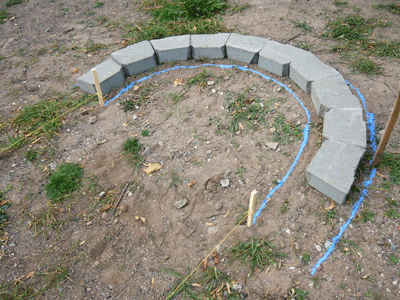We choose a locally produced retaining wall product called Gardenstone from Superior Block in Houghton. Here they are delivering our block and gravel with their nifty remote control crane.
Pictured in the foreground is a grey Gardenstone block (they are available in three other colors for additional cost). The underside of the block is facing up so you see the lip along the back that interlocks one course of block to the next. Each course sets back the dimension of this lip (3/4 inch) from the course below it so your bed area slightly shrinks as you build up. The palette to the right contains the caps for the final course of the wall which will be attached with adhesive to solidify the wall.
Here we are calculating the arc dimension and marking guidelines in preparation for digging the trench for the wall. In order to make an arc we had to knock off the ears on the back of each block. We discovered the tightest diameter circle the block can make without cutting is 6-feet, slightly over the maximum width you want to make a raised bed and still be able to comfortably reach the middle (5-feet is recommended). The final height of our beds will be about 16-inches, but Gardenstone is approved for wall heights up to 20-inches.
With the beds all laid out, we brought in the muscle! The Western Upper Peninsula Health Department (WUPDHD) helped organize and sponsor a Make a Difference Day (Oct 23: the nation's largest day of service) event at the garden for a group of AmeriCorps workers. The photo above shows us digging the trench that will eventually be filled with gravel.
The blocks are set on grade (south facing slope) in the gravel trench and leveled from side to side. We used sheets of cardboard (bike boxes supplied by Downwind Sports in Houghton) as our weed barrier on the bottom of the bed.
Even more AmeriCorps workers showed up at this point and we power shoveled the compost into the bed. These folks work hard! Thank You AmeriCorps!
The day wouldn't be complete without a little celebratory hula hooping to christen the new bed. Go Keren! Go Viki!
The project continues...
Building the third raised bed took a lot more time with only 2-3 of us on task. Fortunately a Community Service Work crew stopped by for a bit (thanks to the Hancock Department of Public Works) and helped us move soil into the bed. Thanks guys!








